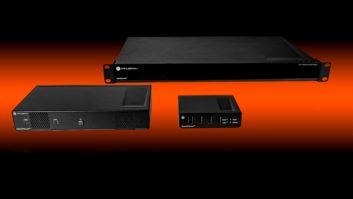
IP-centric AV systems for meeting rooms bring opportunities for integrators and end users, writes David Shamir, director, product management at Atlona.
The benefits of AV-over-IP integration are often associated with large installations for enterprises and other organisations. However, there are also wide-ranging advantages for integrators and AV/IT customers when considering entirely IP-based system installations for individual meeting spaces.
In an all-IP meeting-room system, AV devices such as encoders, decoders and audio equipment are connected to the network. This simplifies integration by allowing the use of standard data network infrastructure.
An all-IP system design can be sized exactly to the quantity of inputs and outputs required for the application, rather than selecting a fixed-configuration AV switcher. A system design built on networked encoders and decoders is very easy to duplicate across other rooms, and can also be adapted to various room sizes or requirements.
When considering multiple systems throughout a building or campus, going the all-IP route introduces further integration efficiencies through the use of centralised control processing, videoconferencing and DSP resources to serve multiple room systems.
An IP-based meeting room system easily interconnects into a centralised LAN with other rooms, facilities and buildings. The result is powerful: wide-ranging opportunities to share content between rooms, serve overflow spaces, facilitate company-wide presentations and on-demand training sessions, and so much more. AV over IP can also solve some communication challenges that otherwise would not be feasible.
Flexibility and reliability
Another key benefit of IP as the AV distribution infrastructure is the relative ease of planning for future considerations, such as bringing in new systems and upgrading existing installations. By planning ahead and integrating AV systems over networks, you’re also ready to re-engage with your customers down the line with cost-effective opportunities to enhance or expand their AV communication capabilities.
AV-over-IP integration offers yet another important advantage as compared to traditional systems: the ability to provide operational redundancy. Depending on the system architecture and equipment specified, a networked AV system design can afford the opportunity to build in redundancy and automatic failover, ensuring continuous AV communications even in the event of an unexpected malfunction or connectivity issue.
The decision to integrate AV systems over a facility’s IP network infrastructure also provides the customer and the integrator with a powerful opportunity to manage all AV operations centrally.
IP-based AV systems can be integrated easily and seamlessly into an AV asset management resource, to be accessed, monitored and managed from a web-based portal. This approach also enables system integration to be streamlined by configuring a system and then duplicating the configuration across similar systems in the facility.
Once AV integration is completed, the same AV asset management resource can be used by IT admins and technicians to maintain AV operations.
Additional benefits
There are many other advantages in an all-IP world of interconnected meeting room AV systems.
- AV system standardisation: IP-based systems are easy to standardise across an organisation, even worldwide for multinational enterprises.
- Simplify inventory requirements: For dealers, it’s just a matter of stocking encoders, decoders and network switches.
- Streamline control-system integration: No matter how large or small the system might be, system control is always integrated through the command set or API for the encoder and decoder.
- System upgrading: IP is the logical path for adding new capabilities to an existing AV installation, or planning a complete system overhaul. Networked AV systems over gigabit Ethernet easily allow upgrades with existing network cable plants.
The migration of AV signal distribution from traditional circuit-based switching to IP networks isn’t just about adopting newer technology; it also ties in with the need to facilitate open collaboration and content sharing. This necessitates AV systems that are flexible and ready to respond to the ever-changing demands of workers and organisations for effective communication.







